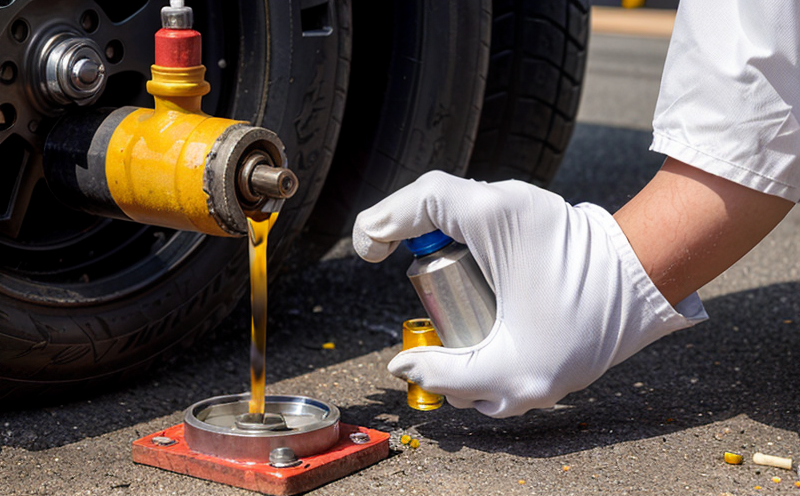ISO 10478 Phosphorus Content Testing of Lubricants
The ISO 10478 standard provides a method for determining the phosphorus content in lubricating oils, greases, and similar petroleum products. This test is particularly important in marine environments where contamination from phosphate esters can have serious implications for equipment performance and safety.
Phosphorus compounds are often added to lubricants as fire retardants or antioxidants. In marine applications, such additives must be carefully controlled to prevent the formation of acidic by-products that could corrode engine components over time. Accurate phosphorus content testing ensures compliance with international maritime regulations while also enhancing operational safety and extending equipment lifespan.
The test procedure outlined in ISO 10478 involves several critical steps, including sample preparation, digestion, analysis via colorimetric methods or atomic absorption spectrophotometry (AAS), and finally reporting results. Quality managers, compliance officers, R&D engineers, and procurement personnel rely on this service to ensure their lubricants meet stringent quality standards.
For instance, in a shipyard setting, testing phosphorus content is crucial for selecting the right lubricant that can withstand extreme conditions without degrading. Compliance with ISO 10478 ensures that lubricants used are not only safe but also optimized for performance under marine conditions.
The importance of this test extends beyond mere compliance; it directly impacts operational efficiency and environmental sustainability. By ensuring that phosphorus levels are within acceptable limits, organizations can prevent costly repairs and improve overall fleet reliability. Additionally, adhering to international standards like ISO 10478 helps maintain a safe working environment for crew members.
In summary, ISO 10478 Phosphorus Content Testing of Lubricants is an essential service that supports the quality management practices of companies operating in marine and ship equipment sectors. It ensures not only regulatory compliance but also operational excellence by providing accurate data on lubricant composition.
Why It Matters
The phosphorus content of lubricants plays a crucial role in determining their suitability for use in various applications, particularly within the marine and ship equipment sector. Controlling phosphorus levels is vital because excess phosphate esters can lead to acidic by-products that cause corrosion and degradation of metal components.
- Prevents Corrosion: Phosphorus compounds act as inhibitors against rust formation. However, an imbalance in their concentration can result in the generation of corrosive acids.
- Ensures Compliance: Many international maritime regulations mandate specific phosphorus limits to safeguard both equipment and personnel health.
- Enhances Efficiency: Lubricants with optimal phosphorus levels perform better, reducing wear and extending service life.
The significance of maintaining correct phosphorus content cannot be overstated. It directly influences the longevity and reliability of marine machinery, which is critical for safety at sea. By conducting this test regularly, companies can identify potential issues early on, thereby minimizing downtime and associated costs.
In conclusion, understanding why phosphorus content matters involves recognizing its dual role as a protective agent and compliance enforcer within the broader context of maritime operations.
Scope and Methodology
The scope of ISO 10478 Phosphorus Content Testing encompasses the determination of total phosphorus content in various types of lubricants, including engine oils, gear oils, hydraulic fluids, and greases. This service is particularly beneficial for marine applications where high-temperature environments can accelerate oxidation processes.
The testing methodology typically involves several key steps:
- Sample Preparation: Samples are collected from storage tanks or containers according to standard sampling practices.
- Digestion: The samples undergo digestion in a suitable acid mixture to ensure complete breakdown of organic matter.
- Analytical Techniques: Colorimetric methods or atomic absorption spectrophotometry (AAS) are used for precise quantification of phosphorus content.
- Reporting Results: The final step involves compiling and reporting the results in accordance with ISO 10478 guidelines.
This structured approach ensures that the testing process is both accurate and reproducible, providing reliable data for decision-making purposes. Compliance officers and R&D engineers benefit greatly from these detailed reports as they provide insights into the effectiveness of current lubricant formulations.
For quality managers, this service offers a valuable tool in monitoring inventory levels and ensuring consistent product quality across different batches or suppliers. Procurement teams can leverage these findings to negotiate better deals with reliable vendors who adhere strictly to international standards.
The precision offered by ISO 10478 Phosphorus Content Testing makes it an indispensable part of any comprehensive maintenance plan for marine equipment. It helps maintain optimal operating conditions, thereby enhancing overall performance and reducing operational risks associated with improper lubrication practices.
Why Choose This Test
- Regulatory Compliance: Ensures adherence to international maritime regulations regarding phosphorus content in lubricants.
- Enhanced Equipment Performance: Optimal phosphorus levels lead to better lubrication, reduced wear, and extended equipment life.
- Safety Assurance: Prevents the formation of corrosive by-products that could endanger crew members and damage critical machinery.
- Cost Efficiency: By avoiding premature failures due to improper lubrication, organizations save on maintenance costs.
- Environmental Considerations: Minimizes waste generation associated with discarded lubricants containing excessive phosphorus levels.
- Data Accuracy: Utilizing advanced analytical techniques ensures precise measurement of phosphorus content.
- Reputation Building: Demonstrates commitment to maintaining high standards in marine operations, which can improve stakeholder confidence.
- Sustainable Practices: Supports long-term sustainability goals by promoting the use of environmentally friendly lubricants.
Selecting this test offers numerous advantages that contribute significantly to operational efficiency and safety. From regulatory adherence to enhanced performance metrics, choosing ISO 10478 Phosphorus Content Testing aligns perfectly with modern quality management practices in marine environments.





